More Wondrous and Weird than Fantasy: Dell Science Fiction Reviews
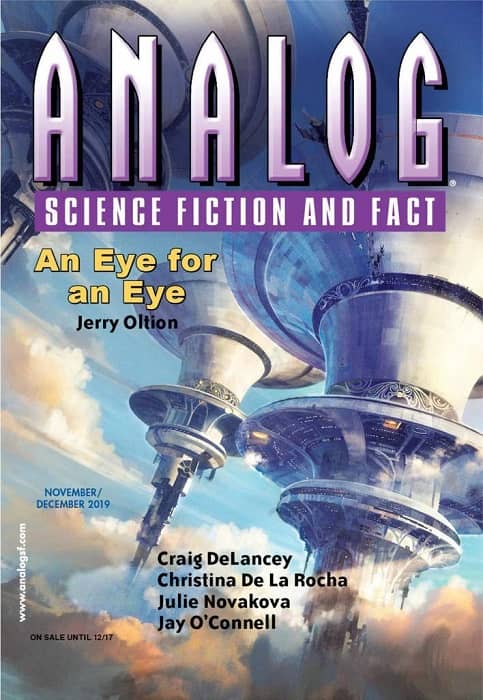 |
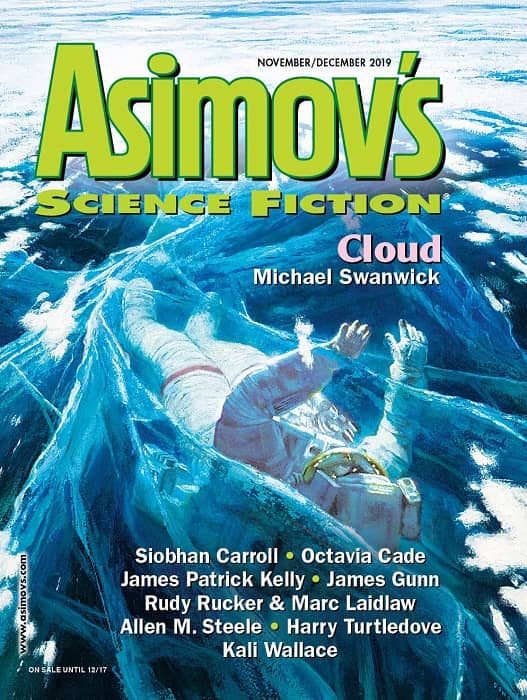 |
Covers by Tuomas Korpi and Donato Giancola
Spoiler warning: I choose to write unrestrainedly about all content in these magazines.
I’ve been reading Asimov’s Science Fiction regularly for — oh — maybe ten or fifteen years now. I began by “checking in.” I first picked it up from my newsstand in a bookstore to investigate the “current discourse,” while I focused most of my attention on my graduate studies and my own interests in the classics, both outside of and within the genre. But then I found myself, almost unconsciously “re-checking” in until, here I am, more than a decade later, regularly ingesting a paper mail subscription.
My involvement with Analog Science Fiction and Fact began similarly but much more recently. Idle curiosity about this “hard” science fiction thing had me sampling an issue off an electronic bookshelf, then another, then another. Here’s the thing about hard science fiction: it “blows my mind.” “Real” science is infinitely more wondrous and weird than fantasy — and more impressive to me, simply because, though I can write passable fantasy, I don’t have the wherewithal to attempt anything even tangentially based in science fact.
Editor John O’Neill has heard me opinionating on the material in both of these publications for long enough now that, after some prodding and pressuring from him, I endeavor a new series for the year, one in which I review standouts and make observations about the content in these two pulps from Dell Magazines. The material covered will be totally arbitrary. I will address only what seems most notable; my comments will not be comprehensive. Finally, my lens is focused on these two, ignoring all other science fiction publications, only because these happen to be the magazines I read. I do read things other than short speculative fiction, and I’m not interested in making a full time job out of the latter. Even though I have been out of graduate school for many years, I still read the classics once in awhile.
[Click the images for science-fiction-sized versions.]
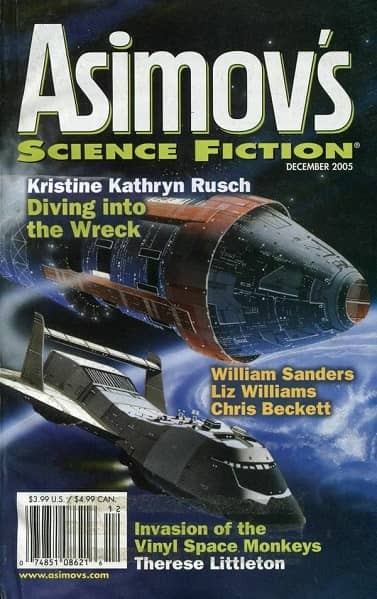 |
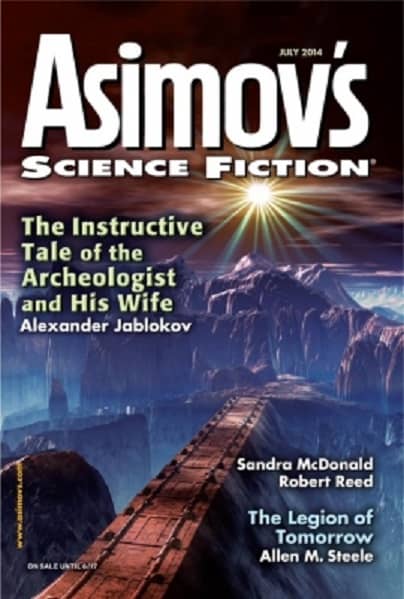 |
Asimov’s Science Fiction, December 2005 (cover by Jean-Pierre Normand) and July 2014 (Shutterstock)
The Discourse
Kristin Kathryn Rusch, Allen Steele, and Ray Nayler are three regular writers for Asimov’s, contributions from whom I always am excited to see present in new pages. Both Rusch and Steele are working on developing their respective series. Rusch’s Diving Universe series (which opened with “Diving Into the Wreck” in the December 2005 issue) is simply one of the coolest spacefaring and spaceship milieux I have read. Steele’s ongoing Arkwright epic (which started with “The Legion of Tomorrow” in the July 2014 Asimov’s) began with a literalizing of how science fiction writers influence scientific futures until arriving at a far future sort of noir rediscovery of the history of human colonization on a distant planet.
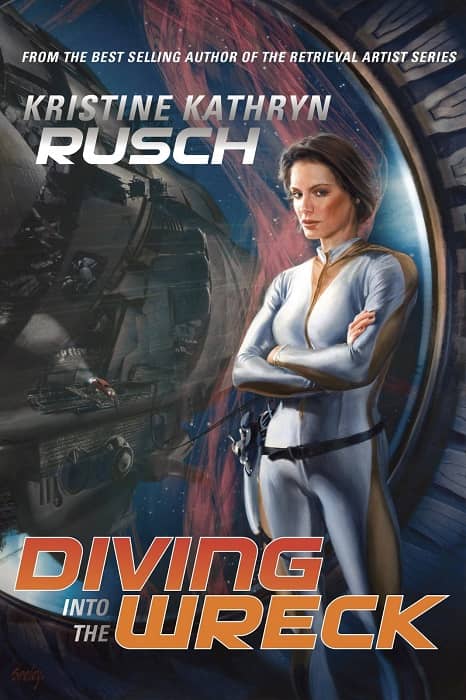 |
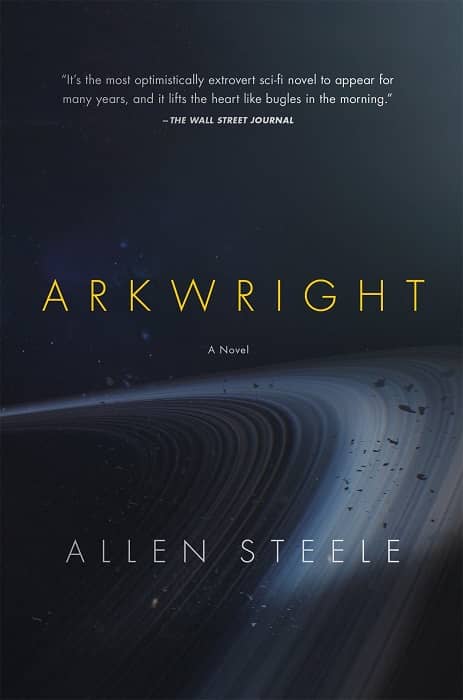 |
Diving Into the Wreck (Pyr, 2009, cover by David Seeley), and Arkwright (Tor, 2016, cover Victor Mosquera)
Nayler’s works, though not interconnected in any apparent way, always can be trusted to be wondrous, mind bending and philosophical. His latest, in the Nov/Dec 2019 release, his “The Disintegration Loops,” demonstrates his skill ably. He portrays a world in which WWII was won by the Allies through the use of technology salvaged from a crashed spaceship. In this world, the victors and survivors continue their work in the midst of vast guilt, and the question of which “side” has perpetrated the most grievous outrages is brought into intense focus as spies use alien technology to live the memories of the recently deceased. I couldn’t help but imagine how this story would make such a cool movie or TV series, it’s crafted with such a cinematic sophistication.
Analog contributions tend to be shorter and from a more diverse array of writers. Perhaps this is because of the stated mission of the magazine to situate all its fiction in “real” science. As such, sometimes works in this publication astound me with profound insight.
A recent illustration of this can be found in Craig DeLancey’s “Sojourner” in the Nov/Dec 2019 issue. AI has escaped into the world, and a government agency is trying to track all of them down, ostensibly to delete them. The narrative involves a perspective character trying to smuggle an AI through a kind of underground railroad. As such, there are direct and arresting correspondences between the title of this story, which also is the selected name of the AI featured in this story, and the historical person Sojourner Truth. All of this works very well on the sympathies of the reader, which double those of the human perspective character. But at one point of the story the smuggler is told that the AI about which she (and the reader) cares so much “is all front-end. … It’s all interface. … This AI is nothing, absolutely nothing, except procedures to exploit your better human nature so that it can encourage you to help it spread copies of itself.” In other words, the AI Sojourner is nothing but code, malware, designed to manipulate the sympathies of people to propagate it (kind of like fiction — and this story — itself).
But, but… as the perspective character asks, isn’t this likewise an effective description of a human, and isn’t the converse the same sort of thing plantation owners would say about the persons they were holding as slaves, that such persons were very good at “passing” at being real people, that they merely manipulated well-meaning but naive sympathies? The character seeking to eradicate Sojourner and others like it needs to study this AI in preparation for what he sees as a possibility for nations and dictators to “hack brains through talk alone.” It’s a compelling and mind-dizzying dialectic.
I’m certain that 2020 will bring more genius work in these pages, from these writers and from others. See you again soon.
Asimov’s Science Fiction and Analog are available wherever magazines are sold, and at various online outlets. Buy subscriptions at the links below.
Asimov’s Science Fiction (208 pages, $7.99 per issue, one year sub $47.94 in the US) — edited by Sheila Williams
Analog Science Fiction and Fact (208 pages, $7.99 per issue, one year sub $47.94 in the US) — edited by Trevor Quachri
The current issues of Asimov’s and Analog are on sale until December 17. See the complete contents of both issues here, and all our recent magazine coverage here.
Gabe Dybing has been a small magazine editor (Mooreeffoc Magazine 2000-2001), often a writer, and usually a gamer. He is most interested in the “northern” fantasy tradition and frequently examines intersections between that topic and gaming. For Black Gate he has contributed many articles, including pieces on Poul Anderson, J.R.R. Tolkien, and roleplaying games. His most recent was a look at the Against the Darkmaster Kickstarter.